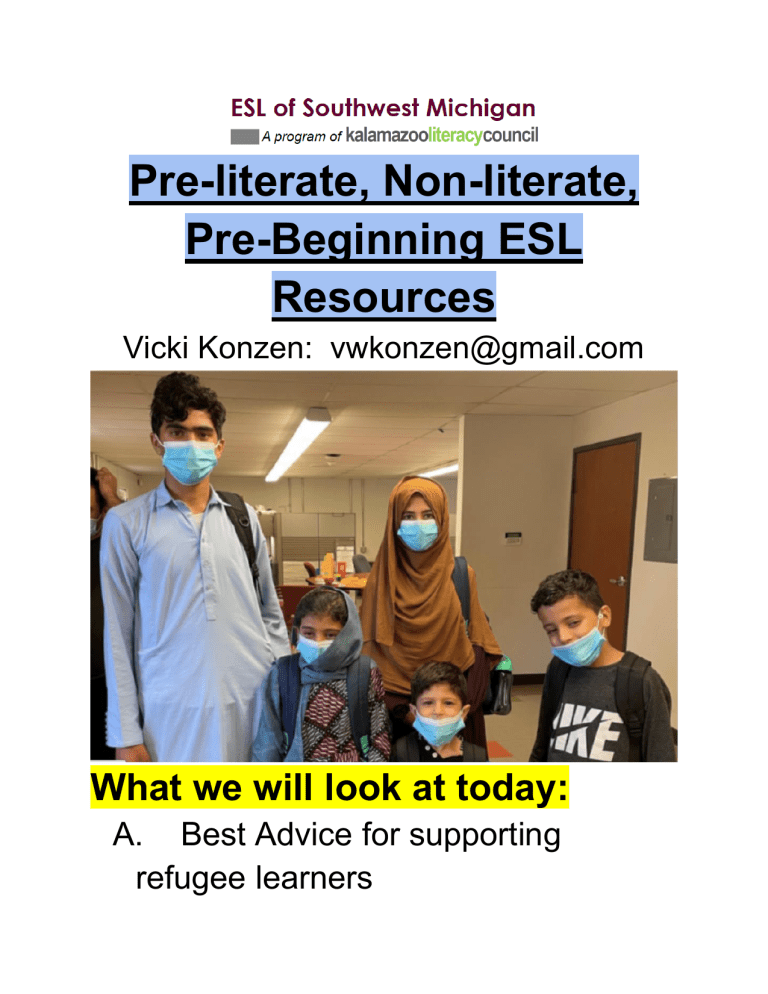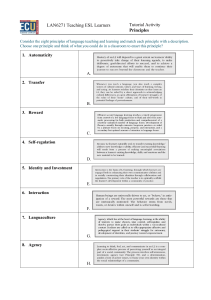
Pre-literate, Non-literate, Pre-Beginning ESL Resources Vicki Konzen: vwkonzen@gmail.com What we will look at today: A. Best Advice for supporting refugee learners B. Tips for Teachers and Tutors: Objectives and methods C. Textbooks to use with PreLiterate, Non-literate, and Low Literacy Learners D. Using your Phone to Teach ESL E. Free Hands-on Materials to Print F. Online resources G. Lesson for Non-literate Learners using ESL Literacy Readers A. Best Advice for Supporting Refugee Learners 1. Link: Supporting Afghan Learners at School Many links on this website. Example: Link: A New Life and Worry About Those Left Behind: Texas Schools Prepare for Wave of Afghan Refugee Students “Using images or drawings can help students express what they know conceptually before they have the words.” 2. Culture Link: Cultural Atlas: Afghan Core Concepts Greetings Religion Family Naming Etiquette Communication Other Considerations Do's and Don'ts (example): Example: “Do not put photos of Afghan refugees on social media. It may put family members still in Afghanistan in danger.” 3. Link: Afghan Languages: Pashto, Dari, and Farsi– one language, or three? “While Dari and Farsi are two accents of the same language, Pashto is a different language. Dari, Farsi, and Pashto both use the Arabic Alphabet, but they are completely different from the Arabic language.” 4. Free link: Pashto/English Lessons, to listen to online (audio only), or to print out as pdfs: 5. YouTube channel link: English for Persians B. Tips for Teachers andTutors Objectives for teaching emergent readers 1. Link: Activities for Tutoring a Pre-Literate Student 1. Eight (8) Things You Can Do One-to-One https://www.literacymn.org/educator-resources 1. Get out of the class: every outing is an ESL lesson. 2. Mentoring Resources for Teaching English https://www.refugeeone.org/uploads/1 There is a long list of links. Example: Link: Survival English: What do we need to teach? 3. Link: Making It Real: Teaching Pre-literate Adult Refugee Students 4. Curriculum Guidelines for 3 Beginning Levels Link: elderliteracy.org/resources 6. Where to Begin with Pre-/Non-literate Adults (Schwartz) “My name is Rebecca. What’s your name?” If there is no recognition, I place my hand on my chest and say, “Rebecca”. Then I tap the student’s shoulder with my right hand. Once introductions are complete, I teach numbers 1 to 12. Every language and culture counts. I often begin by using flash cards and dice. I also use real objects such as buttons, paper clips, or whatever is handy. I don't use my hands or fingers to indicate a number because this varies widely throughout the world and can be easily misunderstood.” 7. Link: Working with Pre-literate Learners Eight Techniques and Methodological Suggestions 1. Use authentic, relevant material. 2. Use culturally specific names, especially from your students’ families. 3. Sequence vocabulary words from concrete to abstract. 4. Teach your students how to be a student. 5. Check in with your students constantly. 6. Use classroom activities to reinforce concepts from your lessons. 7. Go from big to small in terms of writing. 8. Be consistent with your writing and handouts. Start by using all capital letters. 8. Link: Teaching Adults, and ESL Resource Book Tutors and teachers registered with the Kalamazoo Literacy Council (KLC) can get a free copy of this book. Free training in the teaching of reading to adults will be offered by the KLC again in March. Contact Kito for more information or to register for tutor training: kjumanne-marshall@kalamazooliteracy.org “Thank you for your interest! With your help, we can fulfill the KLC's mission of making Kalamazoo County a fully literate community.” 9. Link: Getting to Know You Questions 15 conversation questions for mentors or tutors and their refugee learner (who speak some English) to get to know each other. C. Textbooks for Pre-Literate, Non-literate, and Low Literacy Learners Learners and tutors registered with the Kalamazoo Literacy Council can get free copies of textbooks, workbooks, and materials. Registration link for learners to become a KLC student: KLC Registration Form for Learners Application link to become a KLC tutor: KLC Application Form for Tutors Examples of Textbooks: 1. Link to google files: Basic Oxford Picture Dictionary “This topic-based dictionary focuses on everyday, key vocabulary. It offers 1200 everyday core vocabulary words under 12 topics.” Example: 2. Link to google files: Lifeprints Literacy textbook and workbook Some of the graphics are a bit outdated, but these books help adult ESL students gain the English language skills they need to participate effectively at work and in their communities. To order hard copies: Lifeprints Literacy 3. Link to google files: Laubauch Way to Reading 1 “This student book is for adult learners who have little or no reading skills, and require a uniform, step–by–step approach to reading.” The student can progress through Levels 1-4. Link to order hard copies: New Readers Press: Laubach Way to Reading D. Using your Phone to Teach ESL 1. Google Translate App: a. Speak or type into your phone to translate messages into written Persian, Pashto, and many other languages. b. Send translated messages, photos, and videos to your learner on Whatsapp. c. Jackie Denoyer will teach interested participants how to download these 2 helpful apps: jdenoyer@kalamazooliteracy.org 2. Search for images to show your learner. 3. Video record and share a lesson to review later. (Sherry, an ESL tutor, shared this idea.) “When teaching students how to speak– teaching the names of objects– a simple video taken on your phone can then be sent to the student. Walk around the kitchen, show each object, and name it: “Stove,” while standing in front of the stove, refrigerator, sink, fruits, or vegetables, etc. The video will allow the student to have a visual and auditory example to watch, and allows them to practice speaking the new vocabulary words or expressions you taught.” E. Free Hands-on Materials to Print 1. Beginning ESL Workbook link: Refugee one: English Student Workbook 2. Link: Flash Cards of Things at Home 3. Link: Free Mazes help with learning to write. 4. Link: Free Dot-to-Dot activities help with number or letter sequencing. 4. Link: Hubbardscupboard.org booklets have simple thematic stories to read online or to print. 5. Most Common Words lists, and printable hands-on resources: https://www.eslkidstuff.com/WordLists.htm 6. Link: Prolingua Learning - Sample Lessons Click on the sample lessons (blue letters) to view. 7. Link: Jigsaw Sentences for Low Beginners Print, and have your student cut out words to arrange in sentences. *8. Handwriting practice: make your own tracing and printing pages. Link: Make Worksheets to Trace or Print *9. Link: Handwriting Without Tears This entire workbook is printable. Simple shapes can be printed, then cut out of tag board or foam board, and arranged to form letters for a multisensory activity to do before writing the letters. Worksheets in the book have shaded boxes and starting points to guide the drawing of letters. Small chalkboards and chalk are also recommended for writing practice. F. Online teaching resources 1. Teachabcenglish.com a. Book 1 activities and Book 2 activities (for pre-lits and low beginners) can be viewed online for free. Books can be purchased or downloaded for a fee. b. https://www.abceng.org/library.html Click on Books. You can get a free full preview online to read with your learner: Level 1 Phonics, The ABC Picture Dictionary, etc. c. Easy English Readers, full free previews online: https://www.abceng.org/books.html Link: Lesson for Easy English Reader "Places" d. Home Language Literacy: some bi-lingual materials in a few native languages https://www.abceng.org/hll.html e. Link: 5-Minute Literacy Screening Tool (This screening tool can be printed for free.) 2. Link: ESL Literacy Readers are several different levels of free photo stories to read online (with audio for students); the stories can be downloaded and printed to make into booklets. Link: ESL Literacy Readers Guide for Teachers 3. Link: English Unlocked Phonics Although this book costs $30, there are free sample pages, and free teaching instructions with some of the best practices of teaching letter/sound correlations. 3. Link: https://www.linguahouse.com/ Free conversations to listen to, elementary level to advanced. 4. Link: https://eslflow.com/ Find low beginner and higher worksheets and lesson plans here. Example: 3. YouTube: a. There are many “how to teach English” videos that are very helpful, such as this link: Steps of an Orton Gillingham Lesson- letter g Find several videos which demonstrate the O-G methods of multisensory teaching of reading. b. YouTube also offers many beginning ESL lessons for students that could be shared virtually or in person with a learner. The series below demonstrates how slowly and clearly you need to speak to English learners. Link: Speaking English for Beginners “Esl Class | Learn English Speaking For Beginners | American English In Real Life" 4. BBC "English My Way" https://www.bbc.co.uk/learningenglish/english/cours e/emw Short videos using non-native speakers as actors. 5. Learning Chocolate https://www.learningchocolate.com/ Listen or read and match. 6. Starfall https://www.starfall.com/h/ Online alphabet games for children and families. 7. ESOL courses: Click “Starter” or “beginner” for online games: alphabet matching, vocabulary (British English, like “rubber” for eraser) https://www.esolcourses.com/ 8. International Children’s (online) Library: a few storybooks in different languages to read online. International Children's Digital Library 9. Link: Burlington English* Burlington English (which must be purchased*) is a comprehensive online platform for teaching several levels of English. Lessons are online and interactive. Worksheets can be printed to share with learners inperson, or can be studied together online. (*Burlington English is free for learners and tutors registered with the KLC.)


